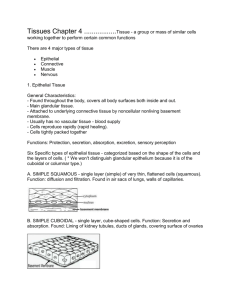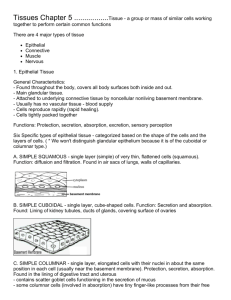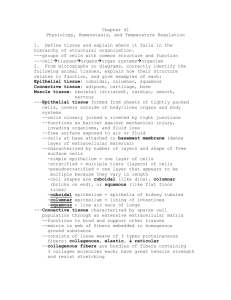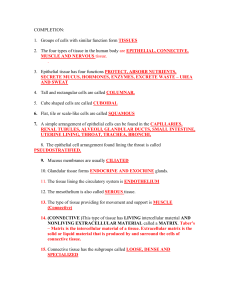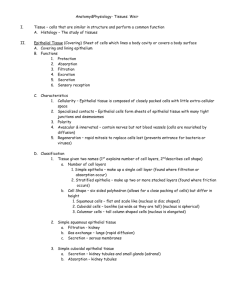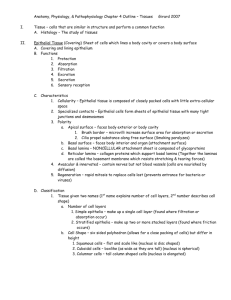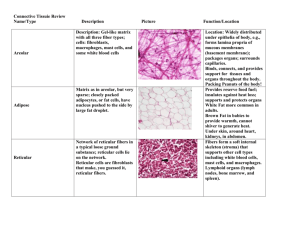Tissues
advertisement
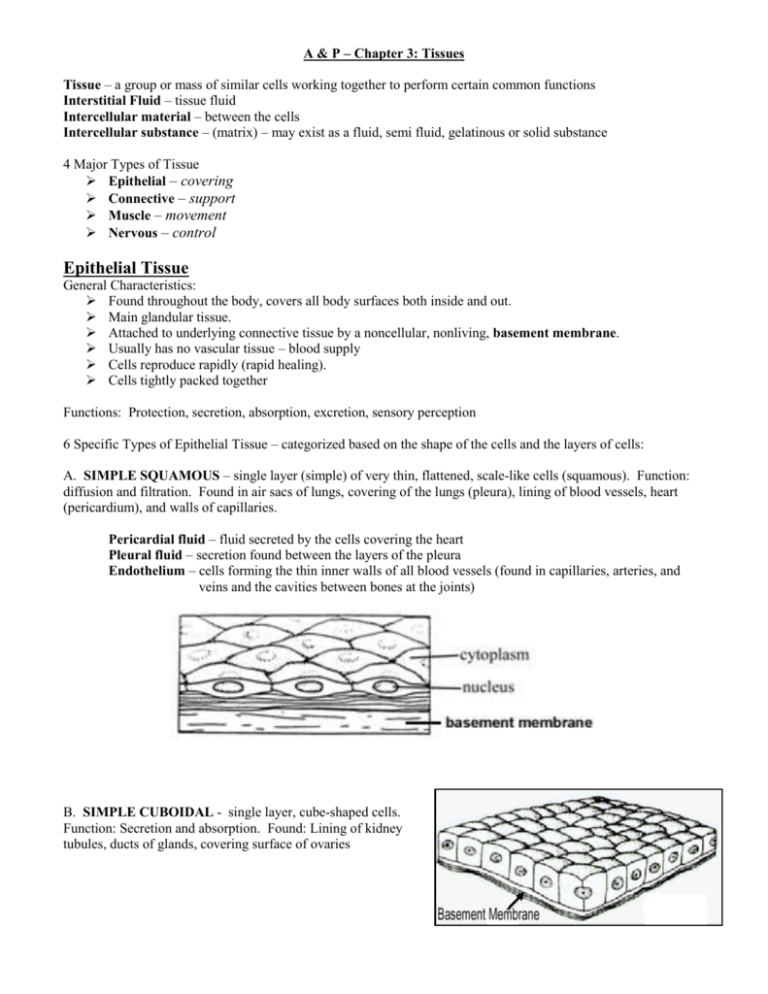
A & P – Chapter 3: Tissues Tissue – a group or mass of similar cells working together to perform certain common functions Interstitial Fluid – tissue fluid Intercellular material – between the cells Intercellular substance – (matrix) – may exist as a fluid, semi fluid, gelatinous or solid substance 4 Major Types of Tissue Epithelial – covering Connective – support Muscle – movement Nervous – control Epithelial Tissue General Characteristics: Found throughout the body, covers all body surfaces both inside and out. Main glandular tissue. Attached to underlying connective tissue by a noncellular, nonliving, basement membrane. Usually has no vascular tissue – blood supply Cells reproduce rapidly (rapid healing). Cells tightly packed together Functions: Protection, secretion, absorption, excretion, sensory perception 6 Specific Types of Epithelial Tissue – categorized based on the shape of the cells and the layers of cells: A. SIMPLE SQUAMOUS – single layer (simple) of very thin, flattened, scale-like cells (squamous). Function: diffusion and filtration. Found in air sacs of lungs, covering of the lungs (pleura), lining of blood vessels, heart (pericardium), and walls of capillaries. Pericardial fluid – fluid secreted by the cells covering the heart Pleural fluid – secretion found between the layers of the pleura Endothelium – cells forming the thin inner walls of all blood vessels (found in capillaries, arteries, and veins and the cavities between bones at the joints) B. SIMPLE CUBOIDAL - single layer, cube-shaped cells. Function: Secretion and absorption. Found: Lining of kidney tubules, ducts of glands, covering surface of ovaries C. SIMPLE COLUMNAR - single layer, elongated cells with their nuclei in about the same position in each cell (usually near the basement membrane). Protection, secretion, absorption. Found in the lining of digestive tract and uterus - contains scattered goblet cells functioning in the secretion of mucus which lubricate the epithelial surface - some columnar cells (involved in absorption) have tiny finger-like processes from their free surface called microvilli (increases surface area) D. STRATIFIED SQUAMOUS – muli-layered, squamous cells. Thicker, more complex tissue. Functions in protecting organs against injury (main function). Found lining body cavities like the mouth and outer layer of skin E. PSEUDOSTRATIFIED COLUMNAR or CILIATED EPITHELIUM appear “stratified” but really a single layer with nuclei at various levels giving the appearance of layered cells. Usually ciliated (tiny, hair-like projections for sweeping materials along a surface). Contains goblet cells. Function: secretion and cilia-aided movement Location: lining air passages like the trachea and tubes of the reproductive system F. TRANSITIONAL EPITHELIUM – thick, layered cuboidal cells. “Stretchable” tissue, also forms barrier to block diffusion. Found: lining of urinary bladder. Connective Tissue General Characteristics: -Most abundant tissue in your body, found throughout -Blood and Lymph tissue -Binds structures together -Provides support, protection, framework, fills space, stores fat, produces blood cells, fights infection, and helps repair tissue. -Composed of more scattered cells with abundant intercellular material matrix -Made up of a ground substance (fluid, semi-solid) and fibers -Most has a good blood supply -Cells can reproduce -3 Common types of cells: 1. mast cells (prevents blood clots) 2. macrophages (phagocytic) and 3. fibroblasts (most abundant, produce fibers) 2 Main Types of Fibers: -collagenous fibers - thick, made of protein collagen, major structural protein in the body, appear in long parallel bundles. Strong, flexible, but not very elastic, also known as white fibers. (bones, ligaments, tendons) - elastic fibers – microfibrils in protein elastin, yellow fibers. Not as strong, but very elastic (respiratory and vocal cords) Categories of Connective Tissue: A. LOOSE CONNECTIVE TISSUE or AREOLAR TISSUE – binds skin to underlying organs and organs to organs, space between muscles, throughout body B. ADIPOSE TISSUE – aka FAT, beneath skin, around kidneys and eyeballs, abdominal membranes; Function: Protective cushion (absorbs jolts and jars), insulation to preserve body heat, stores reserve supplies of energy; cells are called adipocytes; females should not exceed 28% body fat and males should not exceed 18% body fat. C. BLOOD (LIQUID CONNECTIVE TISSUE) – composed of 2 distinct parts: fluid (plasma) and solid components (erythrocytes [red blood cells], leukocytes [white blood cells], and thrombocytes [platelets]) D. FIBROUS CONNECTIVE TISSUE – dense tissue, closely packed, thick collagenous fibers and fine network of elastic fibers. Few cells, poor blood supply, thus slow healing. Tendons – connect muscles to bones Ligaments – connect bones to bones Bone – Osseous Tissue – rigid due to mineral salts; layers – lamellae, Haversian canals, osteocytes (composed of 2 types of cells: osteoblasts and osteoclasts) Cartilage – commonly called gristle Cartilage D. HYALINE CARTILAGE – very fine white (collagenous) fibers; the most common cartilage; covers ends of bones and joints, noise, respiratory passages. ALL cartilage cells are called chondrocytes E. ELASTIC CARTILAGE – more flexible and elastic; external ear and larynx F. FIBROCARTILAGE – very tough, large numerous collagenous fibers; Intervertebral disks, menisci I. RETICULOENDOTHELIAL – found scattered throughout the body Muscle Tissue Specialized to contract, or shorten, which causes movement Accounts for 40-50% of body weight 3 Types: A. Cardiac – wall of the heart – involuntary B. Skeletal – skeletal muscles - voluntary (striated) C. Smooth – in hollow organs, stomach – involuntary(visceral) Nerve Tissue Found in brain, spinal cord, nerves A. Neurons – receive/transmit signals; important in control of body processes 3 types: 1. Motor – carries impulses to muscles 2. Sensory – receives impulses from sense organs 3. Associative – relays impulses from sensory to motor B. Neuroglia – protection, support Tissue Repair (Wound Healing) The body has many techniques for protecting itself from uninvited guests or injury. Local tissue level: skin, mucous membranes, cilia, strong stomach acid Inflammation is a generalized body response that attempts to prevent further injury. Immune response is extremely specific and mounts a vigorous attack against recognized invaders (bacteria, viruses, and toxins). Tissue repair or wound healing occurs in 2 major ways: regeneration and fibrosis. * Regeneration – the replacement of destroyed tissue by the same kind of cells Example: skin * Fibrosis – the repair by dense (fibrous) connective tissue by the formation of scar tissue Example: heart The type of repair is determined by the type of tissue damaged and the severity of the injury. Clean cuts (incisions) heal more successfully. Ragged tears (lacerations) heal more slowly. Steps in Tissue Repair: Capillaries become very permeable, allowing fluid rich in clotting proteins to seep into the unjured area from the bloodstream Clotting proteins construct a clot, which stops the loss of blood and holds the edges of the wound together, forming a scab on the surface. This protects the epithelium while it regenerates just beneath it. Granulation tissue (delicate pink tissue composed largely of capillaries that grow into the damaged area from undamaged blood vessels nearby) form. Scar tissue is strong, but lacks the flexibility of most normal tissues and its inability to perform the normal functions of the tissue it replaces. Therefore, depending on the location, it may severely interfere with the functioning of the particular organ. Developmental Aspects of Cells and Tissues Growth through cell division continues through puberty. Epithelial tissue and cell populations exposed to friction replace lost cells throughout life. Connective tissue remains mitotic and forms repair (scar) tissue. Muscle tissue and Nervous tissue become amitotic by the end of puberty. - Amitotic means that it loses its ability to divide when fully mature, therefore these tissues cannot be replaced by the same cells when damaged/lost. Neoplasm – growths of a particular group of cells (represents abnormal masses) 2 Types: - Benign – noncancerous – usually stay the same size; warts - Malignant – cancerous – metastasize or invade other tissues Tumor – any growth benign or malignant Hyperplasia – increase in size Atrophy – decrease in size
